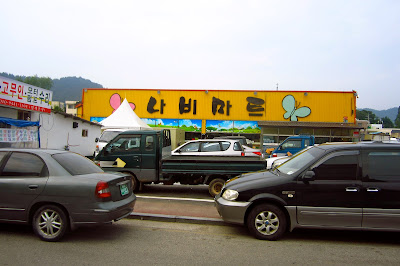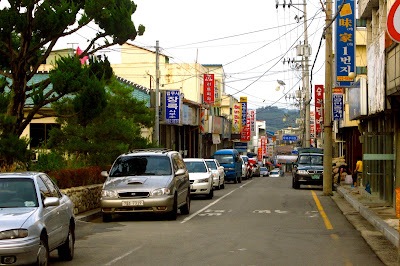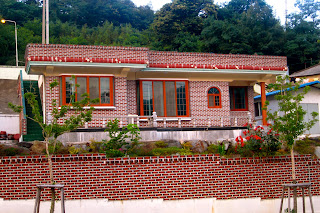As long as I'm on the topic of my home, Hampyeong, and Korean countryside in general, let me show you some more pictures around my neighborhood. Most of the town of Hampyeong is contained in an area west of the small river that runs through the country, and here's another quick map to show you. For a reference on where I live, the two tan areas on the far left of town are schools (함평초등학교 being Hampyeong Elementary, one of my 5 schools)--I live about a block from Hampyeong Elementary. A walk to the river, from my apartment, is about 15 minutes. Here's a picture, the best I could do:
That's right...a screen shot on my computer was really the best possibility
So next, you'll see the river. Which is to say, the stream of half-decent-half-sewage water that flows through the east side of town. Nonetheless, the river maintains a decent depth, especially in the present monsoon season, and there are even fish swimming around in a few isolated holes. Although nothing spectacular to look at, it's a nice, quick escape from any sound that Hampyeong, in all its hustle and bustle, might actually produce.
Some falls and a nice pagoda in the distance, otherwise just nice grassy areas to sit and relax.
Another view of the river, from the opposite side. To the right of the river, you see the beginnings of town; to the left, you see areas that have been designated for crops. Koreans take advantage of any arable land whatsoever, and this is a good example of just that.
So considering most of my schools are out of town, I'm usually taking the bus between 3 and 5 days a week. When I return, it's usually by bus as well--and here's what it looks like coming back into town: there's a small bridge that crosses the river, decorated with (what else?) butterflies.
Better to walk and think about how big Hampyeong seems to look from here, despite all evidence of the contrary
After crossing the river, you find yourself on yet another one of Hampyeong's main streets. Let's break down this picture: We have parked cars (but mostly flat-bed trucks for farmers) on the left, and not on the right--though this is sometimes the case, it's also the case that, in most of Hampyeong, cars will park, with little regard to traffic, on both sides of the road, causing some really awkward traffic patterns around town. In this particular case, there is no parking on the right side--but were these signs not here, you can assume all vehicles would be left snuggly aligned with building walls. There are also no traffic lights around the main part of town--instead, it's just a game of chicken, or mutual trust, or mutual destruction, whatever you prefer. As much as the "betterment of the team or community" ideal is engrained into the Korean psyche, all seems forgotten when one has places to go, things to do. And this, always, is the case throughout Korea--the patience to let pedestrians cross, or allow another car through first, is simple not a virtue around here.
Sure, it looks quiet...
Another anecdote about Korean life that really surprised me, in both city and countryside, is the abundance of churches. And I'm not really thinking about a variety of churches, in the way that we think--here's a temple, there's a cathedral, here's a mega-church, there's a mosque, and, oh look, what a cute steeple over there! In Korea, as far as the naked eye is concerned, if you're a church-goer and not a practicing Christian, you're frankly out of the loop. Churches tend to look very similar to one another here--all relatively small, for the most part, in one or two room buildings, always with steeples that transcend all other buildings, complete with crosses that, come nightfall, lights up a fluorescent red. Here are two such examples:
Two of Hampyeong's small, but prominent churches
Another cool, strange, mouthwatering, or repulsive feature of my town is, as evidenced in the following picture and in my previous post, the presence of hearty Korean food wherever you go. In some cases, it's tarps of garlic, drying in the sun; in others, soggy onions piled high like traffic barriers. In this case, it's a simple, odorless staple: rice.
Pretty cool to be able to leave about 1000kg of rice stashed with doors wide open with the expectation of not a soul touching said rice, eh?
This is one of my favorite pictures of my town, because it says quite a lot. With that in mind, I'll stop chirping about it and let have a chuckle at a true example of Hampyeong's role as an mini-agricultural hub.
I see this guy rolling through town on most days--but you better believe that, on market day, he's dressed to the nines.
Here's another look at one of Hampyeong's main streets...quiet as usual
One thing that I didn't really think twice about in coming to Korea was the issue of banking. I assumed my Visa might cut it at most places, and I largely assumed wrong. Here's my bank, that which is probably the chosen bank for the majority of Koreans living in rural Jeollanam-do province--Nong Hyup, known endearingly as NH. It's mostly a farmers' bank, but is just prominent as any other. Conveniently, too, it has locations even in some of the smallest village centers in Hampyeong County, so I can pay bills during my lunch break. That, my friends, is pretty cool. Of course, to transfer money home, pay bills, receive new bank books, and find some answers to simple account questions, a certain amount of Korean language is inevitably involved--but having a co-teacher present always helps, too.
Nong Hyup, my money managers.
Lastly, I have to break down one more aspect of life in Korean that is somewhere between western reality and Korean perception--coffee shops. Coffee shops all across Korea seem to be, in a way, stuck between what we as foreigners tend to see and what Koreans want to see. It's often difficult to find something as simple as drip coffee on the menu, for better or worse, and accordingly it doesn't appeal to people here--most menu items consist of various iced or hot green teas, lattes, cappuccinos, or smoothies, and simple bean coffee nowhere in sight. Irked as I was to find out that an extremely watered down espresso shot was the closest I'd get to real coffee at most places, I was immediately thankful for kind service, free wi-fi, and other good treats.
...Although that's another tip I have about pastries, cakes, and other foods in some of these coffee shops as well--as delicious as they look, it's often more about presentation; more often than not, the taste doesn't always live up to the image, and just when you think you've found a beautiful, custard-filled chocolate doughnut...you have just bitten into a rice-based bread with sweet red bean paste (the chocolate) and something that vaguely resembles a bitter apricot jam (the custard). Anyway, here are two extremely popular chains across Korea that, hilariously enough, both seek to invoke visions of French cafes in the minds of customers--"Paris Baguette" and "Tous les Jours."
Better atmosphere.
Better overall coffee/food.
The parting shot I'll leave you with is one of Nabi Mart (literally "Butterfly Mart," or supermarket...as if Hampyeong wasn't already so supposedly "famous" for butterflies, all town facilities must be named accordingly). This is where we, as foreigners, do the majority of the day-to-day shopping; maybe, if you readers are interested, I can take some pictures inside and break down a Korean grocery store. Better save that for a later date...
Anyway, thanks as always for reading, keep me posted with what you think and what else you'd like to know/see. 25 days till I'm home, folks.
Lots of love from the ROK,
Sam






























